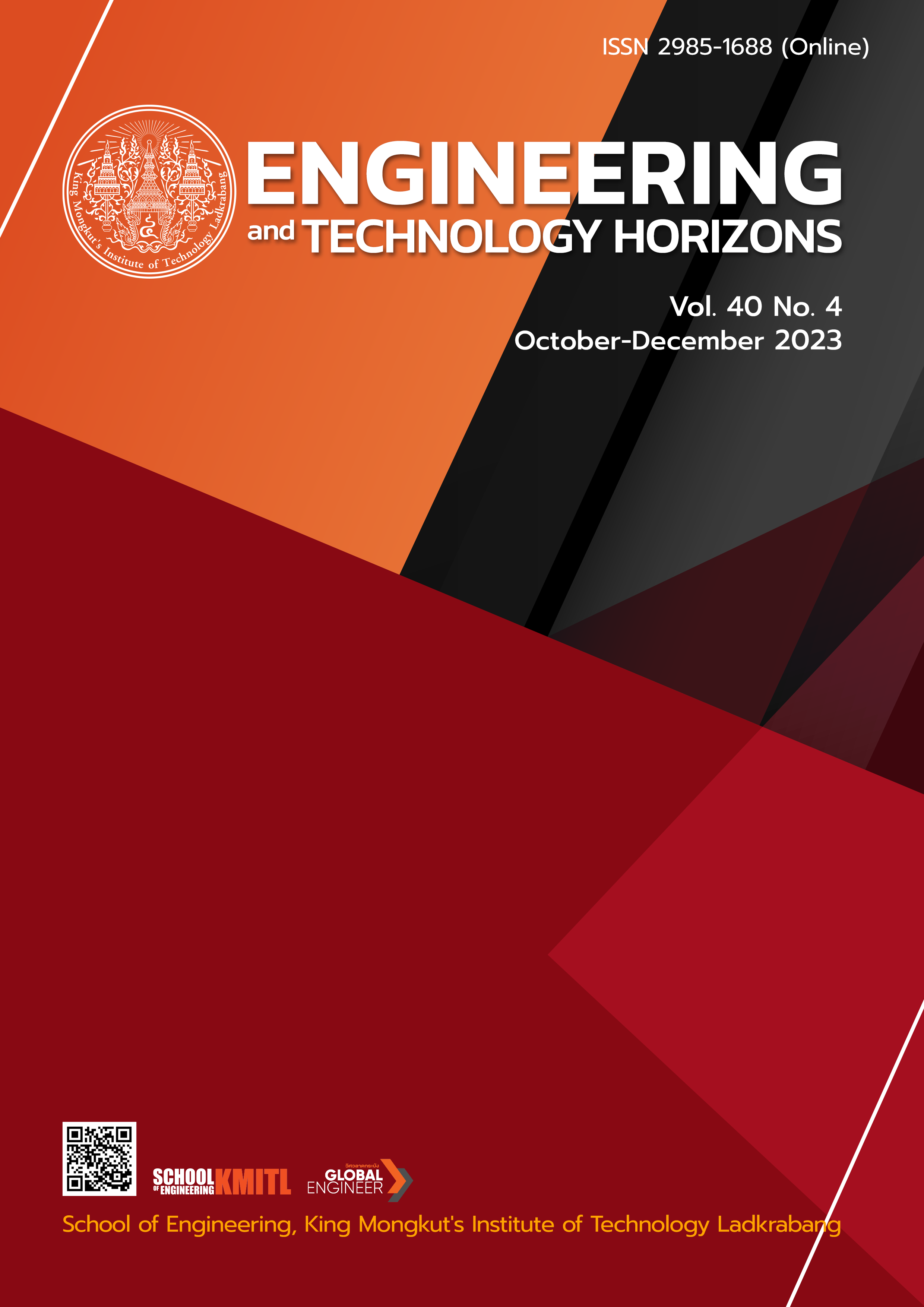Effect of pH by Manganese Salts and Natural Organic Matter on Nanofiltration Membrane Fouling
DOI:
https://doi.org/10.55003/ETH.400411Keywords:
Nanofiltration, Manganese Salts, Natural Organic Matter, Solution Flux, FoulingAbstract
This research aimed to determine the removal performance of manganese affected from solution pH of combined manganese salts with natural organic matter (NOM) using commercial nanofiltration (NF) membrane. The filtration experiments were tested under a dead-end filtration test cell. Variational factors used in this study were the types of manganese salts (i.e. manganese chloride (MnCl2), manganese sulfate (MnSO4), and manganese nitrate (Mn(NO3)2)) with the solution pH of 3, 5, and 7, and ionic strength of 0.01 mol/L. Water samples were prepared with NOM concentration of 10 mg/L, while the operating pressure was operated constant at 60 psig. Experimental results found that the MnSO4 salt provided the highest manganese removal efficiency of 95%, while the removal efficiencies of MnCl2 and Mn(NO3)2 were about 84.86% and 70.7%, respectively. Solution fluxes were not significantly different. In the presence of NOM concentration of 10 mg/L, solution pH of 3–7, it was found that low solution pHs for all conditions provided the highest manganese removal. The removals of NOM were relatively high more than 97%. The mathematical fouling model was done with cake filtration model (CFM) due to NOM accumulation on NF membrane surface.
References
K. Norherdawati, W. M. Abdul and R. S. A. Siti, “Iron and manganese removal by nanofiltration and ultrafiltration membranes: Influence of pH adjustment,” Malaysian Journal of Analytical Sciences, vol. 21, no. 1, pp. 149–158, 2017, doi: 10.17576/mjas-2017-2101-1.
J. E. Marcovecchio, S. E. Botté, C. E. Domini and R. H. Freije, “Heavy metals, major metals, trace elements” in Handbook of Water Analysis, 3rd ed., Boca Raton, FL, USA: CRC Press, 2013, ch. 15, pp. 385–434.
World Health Organization, “Chemical fact sheets,” in WHO. Guidelines for drinking-water quality, in Recommendations, 3rd ed., Geneva, Switzerland: World Health Organization, 2008, ch. 12, sec. 74–80, pp. 390–399.
M. S. Islam, R. Sadiq, M. J. Rodriguez, H. Najjaran, A. Francisque and M. Hoorfar, “Evaluating water quality failure potential in water distribution systems: A fuzzy-TOPSIS-OWA-based methodology,” Water resources management, vol. 27, pp. 2195–2216, 2013, doi: 10.1007/s11269-013-0283-6.
S. Crittenden, R. Reifenberger, J. Hillebrecht, R. Birge, D. Inerowicz and F. Regnier, “Soft lithography based micron-scale electrophoretic patterning of purple membrane,” Journal of Micromechanics and Microengineering, vol. 15, no. 8, 2005, Art. no. 1494, doi: 10.1088/0960-1317/15/8/016.
A. bin Jusoh, W. H. Cheng, W. M. Low, A. Nora’aini and M. M. M. Noor, “Study on the removal of iron and manganese in groundwater by granular activated carbon,” Desalination, vol. 182, no. 1–3, pp. 347–353, 2005, doi: 10.1016/j.desal.2005.03.022.
D. Ellis, C. Bouchardand and G. Lantagne, “Removal of iron and manganese from groundwater by oxidation and microfiltration,” Desalination, vol. 130, no. 3, pp. 255–264, 2000, doi: 10.1016/S0011-9164(00)00090-4.
A. Abdul Kadir, N. B. Othman and N. M. Azmi, “Potential of using Rosa Centifolia to remove iron and manganese in groundwater treatment,” International Journal of Sustainable Construction Engineering & Technology, vol. 3, no. 2, pp. 70–82, 2012.
K. -H. Choo, H. Lee and S. -J. Choi, “Iron and manganese removal and membrane fouling during UF in conjunction with prechlorination for drinking water treatment,” Journal of Membrane Science, vol. 267, no. 1–2, pp. 18–26, 2005, doi: 10.1016/j.memsci.2005.05.021.
J. H. Potgieter, R. I. Mccrindle, Z. Sihlali, R. Schwarzer and N. Basson, “Removal of iron and manganese from water a high organic carbon loading part I : The effect of various coagulants,” Water, Air Soil Pollution, vol. 162, no. 1–4, pp. 49–59, 2005, doi: 10.1007/s11270-005-5992-x.
P. Wu and M. Imai, “Novel biopolymer composite membrane involved with selective mass transfer and excellent water permeability,” in Advancing Desalination, London, UK: IntechOpen Limited, ch. 3, 2012, pp. 57–81.
P. H. Hermans and H. L. Brede′e, “Principles of the Mathematical Treatment of Constant-pressure Filtration,” Journal of the Society of Chemical Industry, vol. 55, no. 2, pp. T1–T8, 1936, doi: 10.1002/jctb.5000550219.
A. Lhassani, M. Rumeau, D. Benjelloun and M. Pontie, “Selective demineralization of water by nanofiltration application to the defluorination of brackish water,” Water research, vol. 35, no. 13, pp. 3260–3264, 2001, doi: 10.1016/S0043-1354(01)00020-3.
J. Lee, S. Jeong, Y. Ye, V. Chen, S. Vigneswaran, T. Leiknes and Z. Liu, “Protein fouling in carbon nanotubes enhanced ultrafiltration membrane: fouling mechanism as a function of pH and ionic strength,” Separation and Purification Technology, vol. 176, pp. 323–334, 2017, doi:10.1016/j.seppur.2016.10.061
Downloads
Published
How to Cite
Issue
Section
License
Copyright (c) 2023 Faculty of Engineering, King Mongkut’s Institute of Technology Ladkrabang

This work is licensed under a Creative Commons Attribution-NonCommercial-NoDerivatives 4.0 International License.
The published articles are copyrighted by the School of Engineering, King Mongkut's Institute of Technology Ladkrabang.
The statements contained in each article in this academic journal are the personal opinions of each author and are not related to King Mongkut's Institute of Technology Ladkrabang and other faculty members in the institute.
Responsibility for all elements of each article belongs to each author; If there are any mistakes, each author is solely responsible for his own articles.






